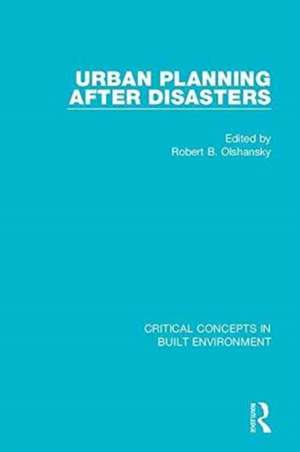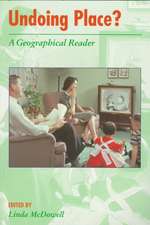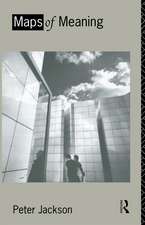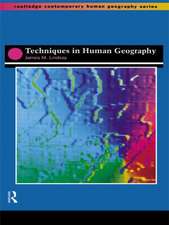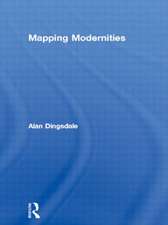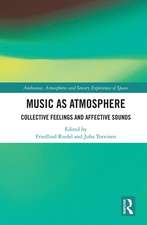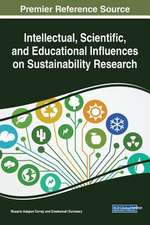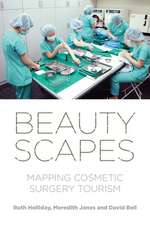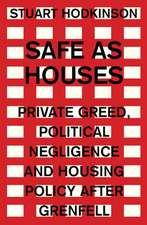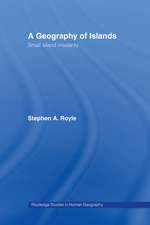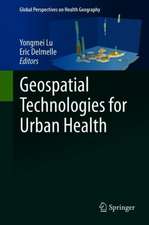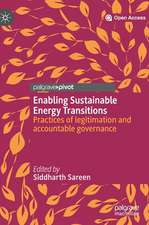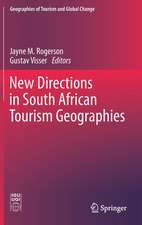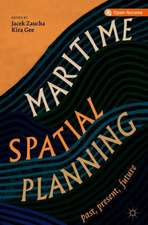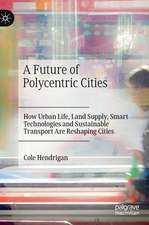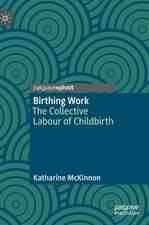Urban Planning After Disasters: Critical Concepts in Built Environment
Editat de Robert Olshanskyen Limba Engleză Hardback – 24 noi 2016
These selections emphasize knowledge regarding reconstruction and recovery of communities, the policies designed to facilitate successful reconstruction, the processes of planning, the processes of reconstruction, and the outcomes of all of the above. They draw from publications describing reconstruction cases all over the world, for which there is a rapidly growing literature. They emphasize governance, management, and planning for reconstruction, and also include some papers that describe and evaluate reconstruction outcomes. The selections emphasize physical reconstruction, but also include key readings on the economic recovery of cities after disasters.The set is introduced in a comprehensive editorial piece by the editor which locates the articles in context and explores the issues and topics at hand.
Preț: 4378.53 lei
Preț vechi: 6822.70 lei
-36% Nou
Puncte Express: 6568
Preț estimativ în valută:
837.84€ • 876.55$ • 695.99£
837.84€ • 876.55$ • 695.99£
Carte tipărită la comandă
Livrare economică 02-16 aprilie
Preluare comenzi: 021 569.72.76
Specificații
ISBN-13: 9781138776531
ISBN-10: 113877653X
Pagini: 1830
Ilustrații: 325
Dimensiuni: 156 x 234 mm
Greutate: 3.31 kg
Ediția:1
Editura: Taylor & Francis
Colecția Routledge
Seria Critical Concepts in Built Environment
Locul publicării:Oxford, United Kingdom
ISBN-10: 113877653X
Pagini: 1830
Ilustrații: 325
Dimensiuni: 156 x 234 mm
Greutate: 3.31 kg
Ediția:1
Editura: Taylor & Francis
Colecția Routledge
Seria Critical Concepts in Built Environment
Locul publicării:Oxford, United Kingdom
Public țintă
Postgraduate, Professional, and UndergraduateCuprins
Volume 1 - Theoretical Foundations: Unique Aspects of Post-Disaster Reconstruction
1. Kates, Robert W. 1977. "Major Insights: A Summary and Recommendations." In Reconstruction Following Disaster, edited by J. Eugene Haas, R. W. Kates and M. Bowdon. Cambridge: MIT Press.
2. Rubin, Claire B. 1985. "The Community Recovery Process in the United States after a Major Natural Disaster." International Journal of Mass Emergencies and Disasters 3(2).
3. Quarantelli, Enrico L. 1999. The disaster recovery process: What we know and do not know from research. Newark, Delaware: Disaster Research Center, University of Delaware.
4. Olshansky, R. B., and Chang, S. (2009). "Planning for disaster recovery: Emerging research needs and challenges." Progress in Planning, 72(4), 200–209.
5. Berke, P. R., Kartez, J., and Wenger, D. (1993). "Recovery after disaster: Achieving sustainable development, mitigation and equity." Disasters, 17(2), 93–109.
6. Berke, P.R., and T.J. Campanella. 2006. "Planning for postdisaster resiliency," Annals of the American Academy of Political and Social Science, 604:192-207.
7. Smith, G., and Wenger, D. (2007). "Sustainable disaster recovery: Operationalizing an existing agenda." In Handbook of Disaster Research, H. Rodriguez, E. L. Quarantelli, and R. Dynes, eds., Springer, New York, 234–257.
8. Lindell, M. and Prater, C. (2003). "Assessing Community Impacts of Natural Disasters." Nat. Hazards Rev., 4(4), 176–185.
9. Hayashi, Haruo. 2007. "Long-term Recovery from Recent Disasters in Japan and the United States." Journal of Disaster Research 2(6): 413-418.
10. Olshansky, R., Hopkins, L., and Johnson, L. (2012). "Disaster and Recovery: Processes Compressed in Time." Nat. Hazards Rev., 13(3), 173–178.
11. Reiss, Claire L. ‘Introduction to the Special Issue’, International Journal of Mass Emergencies & Disasters. Aug 2012, Vol. 30 Issue 2, pp. 120-122.
12. Tierney, Kathleen, Anthony Oliver-Smith. ‘Social Dimensions of Disaster Recovery’ International Journal of Mass Emergencies and Disasters August 2012, Vol. 30, No. 2, pp. 123–146.
13. Daniel J. Alesch , William Siembieda. ‘The Role of the Built Environment in the Recovery of Cities and Communities from Extreme Events’, International Journal of Mass Emergencies and Disasters. August 2012, Vol. 32, No. 2, pp. 197–211.
14. Arendt, Lucy A., Daniel A. Alesch. Communities as Complex, Open, and Self-Organizing Social Systems , pp. 55-84 in Long-Term Community Recovery from Natural Disasters, CRC Press, 2015.
15. Arendt, Lucy A., Daniel A. Alesch. Community Disaster Recovery: Definition, Processes, and Obstacles, pp. 147-176 in Long-Term Community Recovery from Natural Disasters, CRC Press, 2015.
16. Johnson, Laurie A. Hayashi, Haruo. Synthesis Efforts in Disaster Recovery Research. International Journal of Mass Emergencies & Disasters. Aug 2012, Vol. 30 Issue 2, p212-239.
Volume 2 – Governance and Planning: Government Perspectives
Part 1: Governance and management, reconstruction organisations
17. Gavin Smith, Thomas Birkland. Building a Theory of Recovery: Institutional Dimensions International Journal of Mass Emergencies and Disasters 30(2), 147-170. 2012
18. Inam, Aseem. 1999. Institutions, Routines, and Crises: Post-earthquake Housing Recovery in Mexico City and Los Angeles. Cities 16(6): 391-407.
19. Thiruppugazh, V. and Sudhir Kumar. Lessons from the Gujarat Experience: Disaster Mitigation and Management, in Shirish Patel and Aromar Revi, eds., Recovering from Earthquakes: Response, Reconstruction, and Impact Mitigation in India, Routledge, 2010.
20. Thiruppugazh, V. Post-Disaster Reconstruction and Institutional Mechanisms for Risk Reduction: A Comparative Study of Three Disasters in India, pp. 17-39 in Rajib Shaw, ed., Disaster Recovery: Used or Misused Development Opportunity, Springer, 2014.
21. Kumar, Sudhir, Institutional Arrangements for Managing Large-Scale Recovery: Key Lessons from the 2004 Tsunami, in R. Shaw (ed.), Recovery from the Indian Ocean Tsunami: A Ten-Year Journey, 2015
22. Edgington, David W. 2010. "The Planning and Reconstruction Response,"in Reconstructing Kobe: The Geography of Crisis and Opportunity, UBC Press, Vancouver, pp. 77-103.
23. Murosaki, Yoshitero. 2007. "Lessons on Reconstruction Strategies from the Great Hanshin-Awaji Earthquake." Journal of Disaster Research 2(5): 330-334.
24. Olshansky, R. B., Johnson, L. A., and Topping, K. C. (2006). "Rebuilding communities following disaster: Lessons from Kobe and Los Angeles." Built Environ., 32(4), 354–374.
25. Mammen, David. 2007. "Recovery Efforts in New York After 9/11." Journal of Disaster Research 2(6): 502-516.
26. Johnson, L. and Mamula-Seadon, L. (2014). "Transforming Governance: How National Policies and Organizations for Managing Disaster Recovery Evolved Following the 4 September 2010 and 22 February 2011 Canterbury Earthquakes." Earthquake Spectra, 30(1), 577-605.
27. Garnett, Jeffrey D. and Melinda Moore. 2010. "Enhancing Disaster Recovery: Lessons from Exemplary International Disaster Management Practices." Journal of Homeland Security and Emergency Management 7(1): DOI: 10.2202/1547-7355.1711.
28. Johnson, Laurie A. 2014. "Developing a Local Recovery Management Framework: Report on the Post-Disaster Strategies and Approaches Taken by Three Local Governments in the U.S. Following Major Disasters." International Journal of Mass Emergencies and Disasters 32 (2): 242–74.
Part 2: Reconstruction planning processes and plan contents
29. William Spangle and Associates. 1991. Introduction, Chapter 1, and Chapter 5 in Rebuilding after Earthquakes: Lessons from Planners. Portola Valley, CA: William Spangle and Associates, Inc.
30. Balachandran, B.R. Planning the Reconstruction of Bhuj, pages 159-203 in Shirish Patel and Aromar Revi, eds., Recovering from Earthquakes: Response, Reconstruction, and Impact Mitigation in India, Routledge, 2010.
31. Olshansky, Robert B, "Planning after Hurricane Katrina," Journal of the American Planning Association, 72(2): 147-153, 2006.
32. Olshansky, Robert B., Laurie A. Johnson, Jedidiah Horne, and Brendan Nee. 2008. "Planning for the Rebuilding of New Orleans," Journal of the American Planning Association, 74(3): 273-287.
33. Iuchi, K., Johnson, L., and Olshansky, R. (2013). "Securing Tohoku's Future: Planning for Rebuilding in the First Year Following the Tohoku-Oki Earthquake and Tsunami." Earthquake Spectra, 29(S1), S479-S499.
34. Johnson, Laurie A., Long-Term Recovery Planning: The Process of Planning, Chapter 6, pages 92-118 in James C. Schwab, ed., Planning for Post-Disaster Recovery: Next Generation, American Planning Association, Chicago, 2014
Part 3: Pre-disaster planning for post-disaster reconstruction
35. Spangle Associates. 1997. Summary, in The Recovery and Reconstruction Plan of the City of Los Angeles: Evaluation of Its Use after the Northridge Earthquake. Portola Valley, California.
36. Meyer, Sandy, Eugene Henry, Roy E.Wright, and Cynthia A. Palmer, Local Capacity Building Through Pre-Event Planning, Journal of Disaster Research, 5(5):552-564, 2010.
37. Hokanson, J. Barry, and James C. Schwab, Anticipating Disruption, in James C. Schwab, ed., Planning for Post-Disaster Recovery: Next Generation, American Planning Association, Chicago, 2014
38. Topping, Kenneth C. and James C. Schwab, Disaster Recovery Planning: Expectations Versus Reality, pages 42-59 in James C. Schwab, ed., Planning for Post-Disaster Recovery: Next Generation, American Planning Association, Chicago, 2014
39. Berke, Philip, John Cooper, Meghan Aminto, Shannon Grabich & Jennifer Horney. ‘Adaptive Planning for Disaster Recovery and Resiliency: An Evaluation of 87 Local Recovery Plans in Eight States’, Journal of the American Planning Association, 80(4):310-324, 2014.
Volume 3 - Governance and Planning: Community Perspectives
Part 1: Non-governmental organizations, community-based reconstruction, social capital
40. Bolin, Robert and Lois Stanford, The Northridge Earthquake: Community-based Approaches to Unmet Recovery Needs, Disasters 22(1):21-38, 1998.
41. Oliver-Smith, Anthony, and Goldman, Roberta A. 1988. Planning goals and urban realities: Post-disaster reconstruction in a third world city. City and Society 2(2): 105-126.
42. MacRae, Graeme, and David Hodgkin, Half full or half empty? Shelter after the Jogjakarta earthquake, Disasters, 35(1): 243-267, 2011.
43. Barenstein , Jennifer Duyne and Sushma Iyengar, India: From a culture of housing to a philosophy of reconstruction, pages 163-188 in M. Lyons and T. Schilderman, eds., Building Back Better: Delivering people-centred housing reconstruction at scale, Practical Action Publishing, Warwickshire, UK
44. Schilderman, Theo and Michal Lyons, 2010. Resilient dwellings or resilient people? Towards people-centred reconstruction, Environmental Hazards 10 (3-4):218-231.
45. Aldrich, Daniel P. 2011. "The Power of People: Social Capital’s Role in Recovery from the 1995 Kobe Earthquake." Natural Hazards 56 (3): 595–611.
Part 2: Public Engagement
46. Chandrasekhar, Divya, Yang Zhang, and Yu Xiao. Nontraditional Participation in Disaster Recovery Planning: Cases From China, India, and the United States. Journal of the American Planning Association 80(4): 373-384, 2014.
47. Kweit, M.G., and R.W. Kweit. 2007. "Participation, Perception of Participation, and Citizen Support." American Politics Research 35 (3): 407–25.
48. Vallance, Suzanne, Disaster recovery as participation: lessons from the Shaky Isles, Natural Hazards, 75(2):1287-1301. 2015
49. Nguyen, Mai Thi, and David Salvesen, ‘Disaster Recovery Among Multiethnic Immigrants: A Case Study of Southeast Asians’ in Bayou La Batre (AL) After Hurricane Katrina. Journal of the American Planning Association 80(4): 385-396, 2014.
50. Ganapati, N. Emel, and Sukumar Ganapati. 2009. "Enabling Participatory Planning After Disasters: A Case Study of the World Bank’s Housing Reconstruction in Turkey." Journal of the American Planning Association 75 (1): 41–59.
Part 3: Community relocation after disaster
51. Levine, Joyce N., Ann-Margaret Esnard, and Alka Sapat, Population Disaplacement and Housing Dilemmas Due to Catastrophic Disasters, Journal of Planning Literature 22(1): 3-15, 2014.
52. Iuchi, Kanako, Planning Resettlement After Disasters, Journal of the American Planning Association 80(4): 413-425, 2014.
53. Sipe, Neil, and Karen Vella, Relocating a Flood-Affected Community: Good Planning or Good Politics? Journal of the American Planning Association 80(4): 400-412, 2014.
54. Knobloch, Dennis M., Moving a Community in the Aftermath of the Great 1993 Midwest Flood, Journal of Contemporary Water Research & Education 130: 41-45, 2005.
Volume 4 – Housing and Economy Recovery
Part 1: Housing reconstruction policies
55. Comerio, Mary C. 1998. Thinking About Disasters and Housing, pp. 1-29 in Disaster Hits Home: New Policy for Urban Housing Recovery. University of California Press, Berkeley.
56. Peacock, Walter G., Nicole Dash, and Yang Zhang. 2007. "Sheltering and Housing Recovery Following Disaster." in Handbook of Disaster Research, edited by Havidan Rodriguez, Enrico L. Quarantelli, and Russell Dynes (Eds.). New York, NY: Springer.
57. Kamel, Nabil M.O., and Anastasia Loukaitou-Sideris, Residential Assistance and Recovery Following the Northridge Earthquake, Urban Studies 41(3):533-562, 2004.
58. Zhang, I. and W. Peacock. 2010. "Planning for Housing Recovery? Lessons Learned from Hurricane Andrew." Journal of the American Planning Association 76(1): 5-24.
59. Peacock, Walter G., Shannon Van Zandt, Yang Zhang, and Wesley E. Highfield, Inequities in Long-Term Housing Recovery after Disasters, Journal of the American Planning Association, 80(4): 356-371, 2014.
60. Oliver-Smith, Anthony. 1990. "Post-Disaster Housing Reconstruction and Social Inequality: A Challenge to Policy and Practice." Disasters 14(1): 7-19.
61. Welsh, Mark G. and Ann-Margaret Esnard. 2009. "Closing Gaps in Local Housing Recovery Planning for Disadvantaged Displaced Households." Cityscape: A Journal of Policy Development and Research 11(2): 195−212.
62. Jie Ying Wu and Michael K. Lindell, Housing Reconstruction After Two Major Earthquakes: The 1994 Northridge Earthquake in the United States and the 1999 Chi-Chi Earthquake in Taiwan, Disasters, Volume 28, Issue 1, pages 63–81, March 2004
63. Ganapati, N. and Mukherji, A. (2014). "Out of Sync: World Bank Funding for Housing Recovery, Postdisaster Planning, and Participation." Natural Hazards Review, 15(1), 58-73.
64. Davis, Ian. What have we learned from 40 years’ of experience of disaster shelter? Environmental Hazards 10 (2011): 193-212.
Part 2: Small business recovery
65. Dahlhamer, J. M. and K. Tierney. 1998. "Rebounding from Disruptive Events: Business Recovery Following the Northridge Earthquake." Sociological Spectrum 18: 121-141.
66. Webb, G.R., K.J. Tierney and J.M. Dahlhamer. 2000. "Businesses and disasters: Empirical patterns and unanswered questions," Natural Hazards Review, 1(2): 83-90.
67. Webb, G.R., K.J. Tierney and J.M. Dahlhamer., 2002. "Predicting long-term business recovery from disaster: A comparison of the Loma Prieta earthquake and Hurricane Andrew," Environmental Hazards, 4: 45-58.
68. Xiao, Yu, and Shannon Van Zandt, Building Community Resiliency: Spatial Links between Household and Business Post-disaster Return, Urban Studies, 49(1):2523-2542, 2012
Part 3: Modelling and monitoring social and economic recovery
69. Miles, Scott .B. and Stephanie E. Chang. 2006. "Modeling Community Recovery from Earthquakes," Earthquake Spectra, 22(2): 439-458.
70. Chang, S. E. 2009. "Urban Disaster Recovery: A Measurement Framework and Its Application to the 1995 Kobe Earthquake." Disasters 34: 303-327.
71. Okuyama, Yasuhide. 2007. "Economic Modeling for Disaster Impact Analysis: Past, Present, and Future," Economic Systems Research, 19(2): 115-124.
72. Rose, A. Z., and Lim, D. 2002. Business Interruption Losses from Natural Hazards: Conceptual and Methodological Issues in the Case of Northridge Earthquake. Environmental Hazards, 4, 1-14.
73. Chang, Stephanie E., and Adam Z. Rose, Towards a Theory of Economic Recovery from Disasters, International Journal of Mass Emergencies and Disasters, 32(2): 171-181, 2012
74. Brown, Daniel; Stephen Platt; John Bevington; Keiko Saito; Beverley Adams; Torwong Chenvidyakarn; Robin Spence; Ratana Chuenpagdee; Amir Khan. 2015. Monitoring and Evaluating Post-Disaster Recovery Using High-Resolution Satellite Imagery—Towards Standardised Indicators for Post-Disaster Recovery. Cambridge Architectural Research, Ltd.
75. Cutter, Susan L., Ronald L. Schumann, and Christopher T. Emrich. 2014. "Exposure, Social Vulnerability and Recovery Disparities in New Jersey after Hurricane Sandy." Journal of Extreme Events 01 (01): 1450002.
76. Cutter, Susan, Christopher T. Emrich, Jerry T. Mitchell,Walter W. Piegorsch, Mark M. Smith, Lynn Weber. "Slow Going for Neighbourhoods" in Hurricane Katrina and the Forgotten Coast of Mississippi. (CUP, 2014).
77. Cutter, Susan, Christopher T. Emrich, Jerry T. Mitchell,Walter W. Piegorsch, Mark M. Smith, Lynn Weber. "Uneven recovery" in Hurricane Katrina and the Forgotten Coast of Mississippi. (CUP, 2014).
1. Kates, Robert W. 1977. "Major Insights: A Summary and Recommendations." In Reconstruction Following Disaster, edited by J. Eugene Haas, R. W. Kates and M. Bowdon. Cambridge: MIT Press.
2. Rubin, Claire B. 1985. "The Community Recovery Process in the United States after a Major Natural Disaster." International Journal of Mass Emergencies and Disasters 3(2).
3. Quarantelli, Enrico L. 1999. The disaster recovery process: What we know and do not know from research. Newark, Delaware: Disaster Research Center, University of Delaware.
4. Olshansky, R. B., and Chang, S. (2009). "Planning for disaster recovery: Emerging research needs and challenges." Progress in Planning, 72(4), 200–209.
5. Berke, P. R., Kartez, J., and Wenger, D. (1993). "Recovery after disaster: Achieving sustainable development, mitigation and equity." Disasters, 17(2), 93–109.
6. Berke, P.R., and T.J. Campanella. 2006. "Planning for postdisaster resiliency," Annals of the American Academy of Political and Social Science, 604:192-207.
7. Smith, G., and Wenger, D. (2007). "Sustainable disaster recovery: Operationalizing an existing agenda." In Handbook of Disaster Research, H. Rodriguez, E. L. Quarantelli, and R. Dynes, eds., Springer, New York, 234–257.
8. Lindell, M. and Prater, C. (2003). "Assessing Community Impacts of Natural Disasters." Nat. Hazards Rev., 4(4), 176–185.
9. Hayashi, Haruo. 2007. "Long-term Recovery from Recent Disasters in Japan and the United States." Journal of Disaster Research 2(6): 413-418.
10. Olshansky, R., Hopkins, L., and Johnson, L. (2012). "Disaster and Recovery: Processes Compressed in Time." Nat. Hazards Rev., 13(3), 173–178.
11. Reiss, Claire L. ‘Introduction to the Special Issue’, International Journal of Mass Emergencies & Disasters. Aug 2012, Vol. 30 Issue 2, pp. 120-122.
12. Tierney, Kathleen, Anthony Oliver-Smith. ‘Social Dimensions of Disaster Recovery’ International Journal of Mass Emergencies and Disasters August 2012, Vol. 30, No. 2, pp. 123–146.
13. Daniel J. Alesch , William Siembieda. ‘The Role of the Built Environment in the Recovery of Cities and Communities from Extreme Events’, International Journal of Mass Emergencies and Disasters. August 2012, Vol. 32, No. 2, pp. 197–211.
14. Arendt, Lucy A., Daniel A. Alesch. Communities as Complex, Open, and Self-Organizing Social Systems , pp. 55-84 in Long-Term Community Recovery from Natural Disasters, CRC Press, 2015.
15. Arendt, Lucy A., Daniel A. Alesch. Community Disaster Recovery: Definition, Processes, and Obstacles, pp. 147-176 in Long-Term Community Recovery from Natural Disasters, CRC Press, 2015.
16. Johnson, Laurie A. Hayashi, Haruo. Synthesis Efforts in Disaster Recovery Research. International Journal of Mass Emergencies & Disasters. Aug 2012, Vol. 30 Issue 2, p212-239.
Volume 2 – Governance and Planning: Government Perspectives
Part 1: Governance and management, reconstruction organisations
17. Gavin Smith, Thomas Birkland. Building a Theory of Recovery: Institutional Dimensions International Journal of Mass Emergencies and Disasters 30(2), 147-170. 2012
18. Inam, Aseem. 1999. Institutions, Routines, and Crises: Post-earthquake Housing Recovery in Mexico City and Los Angeles. Cities 16(6): 391-407.
19. Thiruppugazh, V. and Sudhir Kumar. Lessons from the Gujarat Experience: Disaster Mitigation and Management, in Shirish Patel and Aromar Revi, eds., Recovering from Earthquakes: Response, Reconstruction, and Impact Mitigation in India, Routledge, 2010.
20. Thiruppugazh, V. Post-Disaster Reconstruction and Institutional Mechanisms for Risk Reduction: A Comparative Study of Three Disasters in India, pp. 17-39 in Rajib Shaw, ed., Disaster Recovery: Used or Misused Development Opportunity, Springer, 2014.
21. Kumar, Sudhir, Institutional Arrangements for Managing Large-Scale Recovery: Key Lessons from the 2004 Tsunami, in R. Shaw (ed.), Recovery from the Indian Ocean Tsunami: A Ten-Year Journey, 2015
22. Edgington, David W. 2010. "The Planning and Reconstruction Response,"in Reconstructing Kobe: The Geography of Crisis and Opportunity, UBC Press, Vancouver, pp. 77-103.
23. Murosaki, Yoshitero. 2007. "Lessons on Reconstruction Strategies from the Great Hanshin-Awaji Earthquake." Journal of Disaster Research 2(5): 330-334.
24. Olshansky, R. B., Johnson, L. A., and Topping, K. C. (2006). "Rebuilding communities following disaster: Lessons from Kobe and Los Angeles." Built Environ., 32(4), 354–374.
25. Mammen, David. 2007. "Recovery Efforts in New York After 9/11." Journal of Disaster Research 2(6): 502-516.
26. Johnson, L. and Mamula-Seadon, L. (2014). "Transforming Governance: How National Policies and Organizations for Managing Disaster Recovery Evolved Following the 4 September 2010 and 22 February 2011 Canterbury Earthquakes." Earthquake Spectra, 30(1), 577-605.
27. Garnett, Jeffrey D. and Melinda Moore. 2010. "Enhancing Disaster Recovery: Lessons from Exemplary International Disaster Management Practices." Journal of Homeland Security and Emergency Management 7(1): DOI: 10.2202/1547-7355.1711.
28. Johnson, Laurie A. 2014. "Developing a Local Recovery Management Framework: Report on the Post-Disaster Strategies and Approaches Taken by Three Local Governments in the U.S. Following Major Disasters." International Journal of Mass Emergencies and Disasters 32 (2): 242–74.
Part 2: Reconstruction planning processes and plan contents
29. William Spangle and Associates. 1991. Introduction, Chapter 1, and Chapter 5 in Rebuilding after Earthquakes: Lessons from Planners. Portola Valley, CA: William Spangle and Associates, Inc.
30. Balachandran, B.R. Planning the Reconstruction of Bhuj, pages 159-203 in Shirish Patel and Aromar Revi, eds., Recovering from Earthquakes: Response, Reconstruction, and Impact Mitigation in India, Routledge, 2010.
31. Olshansky, Robert B, "Planning after Hurricane Katrina," Journal of the American Planning Association, 72(2): 147-153, 2006.
32. Olshansky, Robert B., Laurie A. Johnson, Jedidiah Horne, and Brendan Nee. 2008. "Planning for the Rebuilding of New Orleans," Journal of the American Planning Association, 74(3): 273-287.
33. Iuchi, K., Johnson, L., and Olshansky, R. (2013). "Securing Tohoku's Future: Planning for Rebuilding in the First Year Following the Tohoku-Oki Earthquake and Tsunami." Earthquake Spectra, 29(S1), S479-S499.
34. Johnson, Laurie A., Long-Term Recovery Planning: The Process of Planning, Chapter 6, pages 92-118 in James C. Schwab, ed., Planning for Post-Disaster Recovery: Next Generation, American Planning Association, Chicago, 2014
Part 3: Pre-disaster planning for post-disaster reconstruction
35. Spangle Associates. 1997. Summary, in The Recovery and Reconstruction Plan of the City of Los Angeles: Evaluation of Its Use after the Northridge Earthquake. Portola Valley, California.
36. Meyer, Sandy, Eugene Henry, Roy E.Wright, and Cynthia A. Palmer, Local Capacity Building Through Pre-Event Planning, Journal of Disaster Research, 5(5):552-564, 2010.
37. Hokanson, J. Barry, and James C. Schwab, Anticipating Disruption, in James C. Schwab, ed., Planning for Post-Disaster Recovery: Next Generation, American Planning Association, Chicago, 2014
38. Topping, Kenneth C. and James C. Schwab, Disaster Recovery Planning: Expectations Versus Reality, pages 42-59 in James C. Schwab, ed., Planning for Post-Disaster Recovery: Next Generation, American Planning Association, Chicago, 2014
39. Berke, Philip, John Cooper, Meghan Aminto, Shannon Grabich & Jennifer Horney. ‘Adaptive Planning for Disaster Recovery and Resiliency: An Evaluation of 87 Local Recovery Plans in Eight States’, Journal of the American Planning Association, 80(4):310-324, 2014.
Volume 3 - Governance and Planning: Community Perspectives
Part 1: Non-governmental organizations, community-based reconstruction, social capital
40. Bolin, Robert and Lois Stanford, The Northridge Earthquake: Community-based Approaches to Unmet Recovery Needs, Disasters 22(1):21-38, 1998.
41. Oliver-Smith, Anthony, and Goldman, Roberta A. 1988. Planning goals and urban realities: Post-disaster reconstruction in a third world city. City and Society 2(2): 105-126.
42. MacRae, Graeme, and David Hodgkin, Half full or half empty? Shelter after the Jogjakarta earthquake, Disasters, 35(1): 243-267, 2011.
43. Barenstein , Jennifer Duyne and Sushma Iyengar, India: From a culture of housing to a philosophy of reconstruction, pages 163-188 in M. Lyons and T. Schilderman, eds., Building Back Better: Delivering people-centred housing reconstruction at scale, Practical Action Publishing, Warwickshire, UK
44. Schilderman, Theo and Michal Lyons, 2010. Resilient dwellings or resilient people? Towards people-centred reconstruction, Environmental Hazards 10 (3-4):218-231.
45. Aldrich, Daniel P. 2011. "The Power of People: Social Capital’s Role in Recovery from the 1995 Kobe Earthquake." Natural Hazards 56 (3): 595–611.
Part 2: Public Engagement
46. Chandrasekhar, Divya, Yang Zhang, and Yu Xiao. Nontraditional Participation in Disaster Recovery Planning: Cases From China, India, and the United States. Journal of the American Planning Association 80(4): 373-384, 2014.
47. Kweit, M.G., and R.W. Kweit. 2007. "Participation, Perception of Participation, and Citizen Support." American Politics Research 35 (3): 407–25.
48. Vallance, Suzanne, Disaster recovery as participation: lessons from the Shaky Isles, Natural Hazards, 75(2):1287-1301. 2015
49. Nguyen, Mai Thi, and David Salvesen, ‘Disaster Recovery Among Multiethnic Immigrants: A Case Study of Southeast Asians’ in Bayou La Batre (AL) After Hurricane Katrina. Journal of the American Planning Association 80(4): 385-396, 2014.
50. Ganapati, N. Emel, and Sukumar Ganapati. 2009. "Enabling Participatory Planning After Disasters: A Case Study of the World Bank’s Housing Reconstruction in Turkey." Journal of the American Planning Association 75 (1): 41–59.
Part 3: Community relocation after disaster
51. Levine, Joyce N., Ann-Margaret Esnard, and Alka Sapat, Population Disaplacement and Housing Dilemmas Due to Catastrophic Disasters, Journal of Planning Literature 22(1): 3-15, 2014.
52. Iuchi, Kanako, Planning Resettlement After Disasters, Journal of the American Planning Association 80(4): 413-425, 2014.
53. Sipe, Neil, and Karen Vella, Relocating a Flood-Affected Community: Good Planning or Good Politics? Journal of the American Planning Association 80(4): 400-412, 2014.
54. Knobloch, Dennis M., Moving a Community in the Aftermath of the Great 1993 Midwest Flood, Journal of Contemporary Water Research & Education 130: 41-45, 2005.
Volume 4 – Housing and Economy Recovery
Part 1: Housing reconstruction policies
55. Comerio, Mary C. 1998. Thinking About Disasters and Housing, pp. 1-29 in Disaster Hits Home: New Policy for Urban Housing Recovery. University of California Press, Berkeley.
56. Peacock, Walter G., Nicole Dash, and Yang Zhang. 2007. "Sheltering and Housing Recovery Following Disaster." in Handbook of Disaster Research, edited by Havidan Rodriguez, Enrico L. Quarantelli, and Russell Dynes (Eds.). New York, NY: Springer.
57. Kamel, Nabil M.O., and Anastasia Loukaitou-Sideris, Residential Assistance and Recovery Following the Northridge Earthquake, Urban Studies 41(3):533-562, 2004.
58. Zhang, I. and W. Peacock. 2010. "Planning for Housing Recovery? Lessons Learned from Hurricane Andrew." Journal of the American Planning Association 76(1): 5-24.
59. Peacock, Walter G., Shannon Van Zandt, Yang Zhang, and Wesley E. Highfield, Inequities in Long-Term Housing Recovery after Disasters, Journal of the American Planning Association, 80(4): 356-371, 2014.
60. Oliver-Smith, Anthony. 1990. "Post-Disaster Housing Reconstruction and Social Inequality: A Challenge to Policy and Practice." Disasters 14(1): 7-19.
61. Welsh, Mark G. and Ann-Margaret Esnard. 2009. "Closing Gaps in Local Housing Recovery Planning for Disadvantaged Displaced Households." Cityscape: A Journal of Policy Development and Research 11(2): 195−212.
62. Jie Ying Wu and Michael K. Lindell, Housing Reconstruction After Two Major Earthquakes: The 1994 Northridge Earthquake in the United States and the 1999 Chi-Chi Earthquake in Taiwan, Disasters, Volume 28, Issue 1, pages 63–81, March 2004
63. Ganapati, N. and Mukherji, A. (2014). "Out of Sync: World Bank Funding for Housing Recovery, Postdisaster Planning, and Participation." Natural Hazards Review, 15(1), 58-73.
64. Davis, Ian. What have we learned from 40 years’ of experience of disaster shelter? Environmental Hazards 10 (2011): 193-212.
Part 2: Small business recovery
65. Dahlhamer, J. M. and K. Tierney. 1998. "Rebounding from Disruptive Events: Business Recovery Following the Northridge Earthquake." Sociological Spectrum 18: 121-141.
66. Webb, G.R., K.J. Tierney and J.M. Dahlhamer. 2000. "Businesses and disasters: Empirical patterns and unanswered questions," Natural Hazards Review, 1(2): 83-90.
67. Webb, G.R., K.J. Tierney and J.M. Dahlhamer., 2002. "Predicting long-term business recovery from disaster: A comparison of the Loma Prieta earthquake and Hurricane Andrew," Environmental Hazards, 4: 45-58.
68. Xiao, Yu, and Shannon Van Zandt, Building Community Resiliency: Spatial Links between Household and Business Post-disaster Return, Urban Studies, 49(1):2523-2542, 2012
Part 3: Modelling and monitoring social and economic recovery
69. Miles, Scott .B. and Stephanie E. Chang. 2006. "Modeling Community Recovery from Earthquakes," Earthquake Spectra, 22(2): 439-458.
70. Chang, S. E. 2009. "Urban Disaster Recovery: A Measurement Framework and Its Application to the 1995 Kobe Earthquake." Disasters 34: 303-327.
71. Okuyama, Yasuhide. 2007. "Economic Modeling for Disaster Impact Analysis: Past, Present, and Future," Economic Systems Research, 19(2): 115-124.
72. Rose, A. Z., and Lim, D. 2002. Business Interruption Losses from Natural Hazards: Conceptual and Methodological Issues in the Case of Northridge Earthquake. Environmental Hazards, 4, 1-14.
73. Chang, Stephanie E., and Adam Z. Rose, Towards a Theory of Economic Recovery from Disasters, International Journal of Mass Emergencies and Disasters, 32(2): 171-181, 2012
74. Brown, Daniel; Stephen Platt; John Bevington; Keiko Saito; Beverley Adams; Torwong Chenvidyakarn; Robin Spence; Ratana Chuenpagdee; Amir Khan. 2015. Monitoring and Evaluating Post-Disaster Recovery Using High-Resolution Satellite Imagery—Towards Standardised Indicators for Post-Disaster Recovery. Cambridge Architectural Research, Ltd.
75. Cutter, Susan L., Ronald L. Schumann, and Christopher T. Emrich. 2014. "Exposure, Social Vulnerability and Recovery Disparities in New Jersey after Hurricane Sandy." Journal of Extreme Events 01 (01): 1450002.
76. Cutter, Susan, Christopher T. Emrich, Jerry T. Mitchell,Walter W. Piegorsch, Mark M. Smith, Lynn Weber. "Slow Going for Neighbourhoods" in Hurricane Katrina and the Forgotten Coast of Mississippi. (CUP, 2014).
77. Cutter, Susan, Christopher T. Emrich, Jerry T. Mitchell,Walter W. Piegorsch, Mark M. Smith, Lynn Weber. "Uneven recovery" in Hurricane Katrina and the Forgotten Coast of Mississippi. (CUP, 2014).
Descriere
This four-volume collection brings together the most important canonical and cutting-edge papers in the essential topic of planning after disasters. This is the first coherent academic reference work to date.
These selections emphasize knowledge regarding reconstruction and recovery of communities, the policies designed to facilitate successful reconstruction, the processes of planning, the processes of reconstruction, and the outcomes of all of the above. They draw from publications describing reconstruction cases all over the world, for which there is a rapidly growing literature. They emphasize governance, management, and planning for reconstruction, and also include some papers that describe and evaluate reconstruction outcomes. The selections emphasize physical reconstruction, but also include key readings on the economic recovery of cities after disasters.The set is introduced in a comprehensive editorial piece by the editor which locates the articles in context and explores the issues and topics at hand.
These selections emphasize knowledge regarding reconstruction and recovery of communities, the policies designed to facilitate successful reconstruction, the processes of planning, the processes of reconstruction, and the outcomes of all of the above. They draw from publications describing reconstruction cases all over the world, for which there is a rapidly growing literature. They emphasize governance, management, and planning for reconstruction, and also include some papers that describe and evaluate reconstruction outcomes. The selections emphasize physical reconstruction, but also include key readings on the economic recovery of cities after disasters.The set is introduced in a comprehensive editorial piece by the editor which locates the articles in context and explores the issues and topics at hand.
